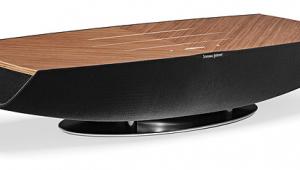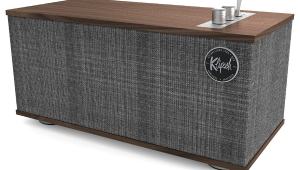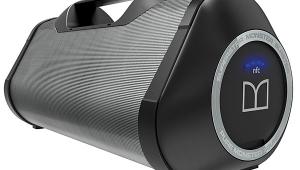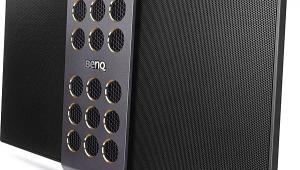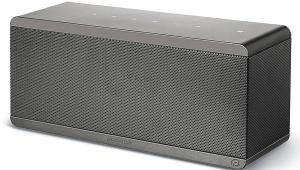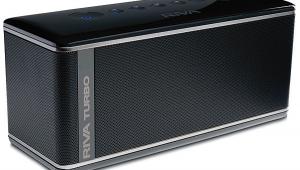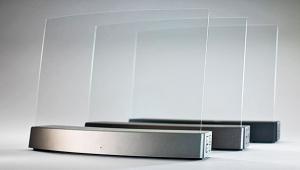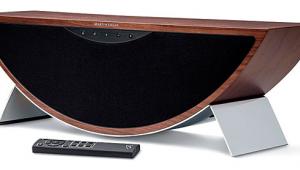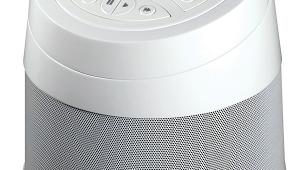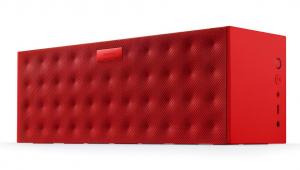Review: Native Union Switch
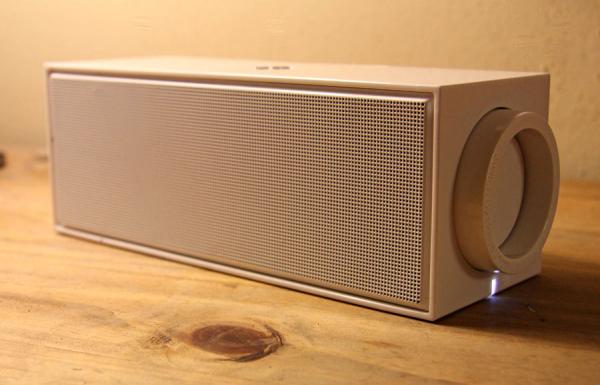
Hey, who decided we should adjust volume by pushing buttons instead of turning a knob? Whether you have to push the button repeatedly, or push, hold, and wait to hit the right volume, is that really easier than twisting a knob? No, it's not. Unfortunately, I know of only one Bluetooth speaker maker who realizes this: Native Union.
On the side of the $149 Native Union Switch Bluetooth speaker is an old-fashioned volume control. Or maybe it'd be better to call it a new-fashioned volume control. It doesn't turn smoothly, it turns in steps-so it's a digital encoder, not an analog potentiometer. In the middle of the knob is the Switch's only button, which controls power and Bluetooth mating.
Maybe this doesn't sound like a big deal, but I loved being able to grab the Switch's volume control to crank it up or turn it down with just a quick twist. It makes a big enough difference to me that I've found myself using the Switch more often than any of the many other Bluetooth speakers I have around.
I loved the rest of the design, too. It's just a rectangular plastic box, but it looks more elegant than any other Bluetooth speaker I've seen. It's designed so it can be used vertically or horizontally, thus the name Switch.
A rubber panel hides the Switch's jacks: a micro USB jack for charging the Switch; a full-size USB jack that works as a voltage output for charging mobile devices; and 3.5mm jacks for analog line in and out. There's a five-LED battery level meter on the bottom (the bottom when it's standing vertically, that is) activated by a tiny pushbutton. The battery's rated at 16 hours of playing time.
Native Union doesn't specify the size of the drivers, but from the website I gather it has two small (looks like about 1 inch) full-range drivers plus an active (powered) woofer that appears to be 2 inches in diameter, apparently mounted in a bass-reflex (ported) enclosure. That's a break from the norm. Most compact Bluetooth speakers just copy the driver layout introduced with the Soundmatters FoxL: two full-range drivers with a passive radiator.
Switch, meet switcher
Although I've been using the Switch for a while, and generally enjoyed the sound, I wanted to see how it compared to a few other compact Bluetooth speakers, including the Braven BRV-1, the RockSteady XS, and the Soundmatters FoxL Dash 7. I connected them to my custom-built testing switcher, which lets me match levels precisely and switch instantly among as many as four audio products. I also asked frequent West Coast headphone panelist Will Huff to give a listen. For Will, the test was blind, because I covered all the speakers with thin black fabric.
I'm kinda stuck on "Chartreuse" from ZZ Top's La Futura-just a completely badass piece of Texas blues filtered through the kick-ass production of Rick Rubin. So when I sat down to seriously eval the Switch, it was the first thing I played. The Switch pretty much nailed it-well, as much as a compact Bluetooth speaker probably can. The sound was very full (is that the powered woofer talking?), the mids sounded smooth, and the treble was a little veiled-sounding and rolled-off, but it all added up to a pleasing tonal balance.
Switching the Switch to a piece of music I haven't talked about three zillion times-Sonny Rollins and the Modern Jazz Quartet's version of "On a Slow Boat to China"-I had essentially the same reaction, noting smooth mids and a soft top end, with nothing sounding harsh or coarse. For a compact Bluetooth speaker, that's pretty high praise. Same result on trumpeter Orbert Davis's take on "Miles Ahead"; the smoothness of the mids makes this a superb speaker for jazz.
More mainstream pop material wasn't quite as compelling through the Switch. Led Zep's "Dancing Days," Steely Dan's "Aja," and Holly Cole's "Train Song" all sounded rather crude and lo-fi, probably because the Switch's soft treble took a bit of definition out of the vocals. On these tunes, the Dash 7 and the Braven BRV-1 outshined the Switch. Will, who listens mostly to pop, had the same reaction: "It sounds like there are some frequencies missing," he said, probably referring to the lack of oomph in the treble.
Measurements
Frequency response
96 Hz to 18.2 kHz, ±5.5 dB 0° on-axis, ±4.1 dB 0° to 30° avg
MCMäxxx™ maximum level test (1 meter)
87 dB
Frequency response measurements were taken with a Clio FW audio analyzer and the MIC-01 measurement mike designed for use with Clio. The measurements above 300 Hz were done at a distance of 0.5 meters with the device atop a 2-meter stand using quasi-anechoic MLS technique. The blue curve in the accompanying graph shows the response at 0° on-axis; the green curve shows the average of measurements taken at 0°, 10°, 20°, and 30° horizontally. To measure response below 300 Hz, I did a ground plane measurement at 1 meter. The ground plane result was then spliced to the quasi-anechoic curves. The ground plane measurement was smoothed to 1/6th octave; quasi-anechoic measurements to 1/12th octave. All measurements were taken using the 3.5mm line input, feeding the left channel only.
The Switch's frequency response is a beautiful thing, at least for a Bluetooth speaker. It's practically flat from 200 Hz to 10 kHz, although the tonal balance is obviously tilted toward the treble. There's a strong bass resonance at 150 Hz, which helps balance out the upward tilt in the tonal balance and also, of course, gives the impression of deeper bass response. Averaged 0° to 30° response is almost identical to, and actually a little smoother than, the on-axis response. It's strange that a device with a subjectively soft tonal balance would yield such a treble-heavy measurement, but perhaps that strong bass bump at 150 Hz obscures some of the treble.
My MCMäxxx™ test-cranking up Mötley Crüe's "Kickstart My Heart" until it sounds harsh or distorted, then backing off the volume just a hair and noting the maximum usable volume at 1 meter-showed that the Switch's output is competitive with the other Bluetooth speakers of comparable size. It hits 87 dB, the same as the Braven BRV-1 and 1 dB above the (much smaller) Soundmatters FoxL Dash 7.
Bottom line
So as some of my relatives in New Orleans might say, "Where we at with this thing?" The Switch has a beautiful midrange, ample bass, and a soft treble. In the context of other compact Bluetooth speakers, it sounds pretty good. It doesn't have the quasi-audiophile dazzle of the FoxL or Dash 7, but I've certainly enjoyed listening to it. And the design is hands-down the best I have seen in a Bluetooth speaker. Strongly recommended for jazz fans, for fhose who abhor bright sound, for design-conscious gadget freaks, and as a gift to anyone who wants a super-friendly, super-stylish sound system to use with their phone.
